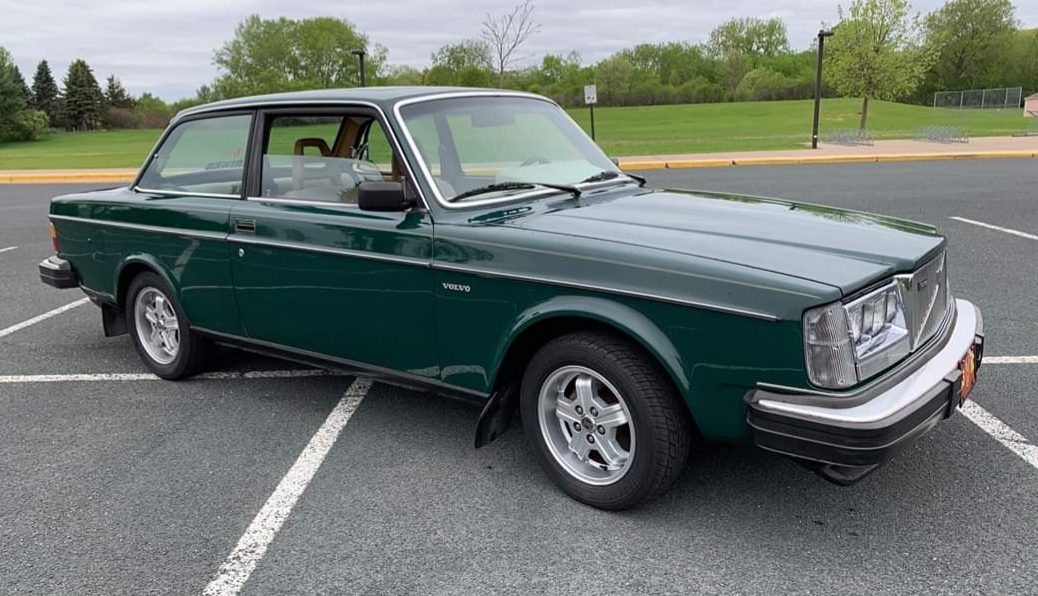
I grew up with 1970s and 1980s Volvos. Though my dad had a 1979 Bonneville sedan and a 1951 Porsche 356 Cabriolet at the time, I came home from the hospital in my mom’s blue 1977 Volvo 245 DL station wagon. My favorite was probably the fire engine red ’88 740 Turbo Sedan. But I digress.
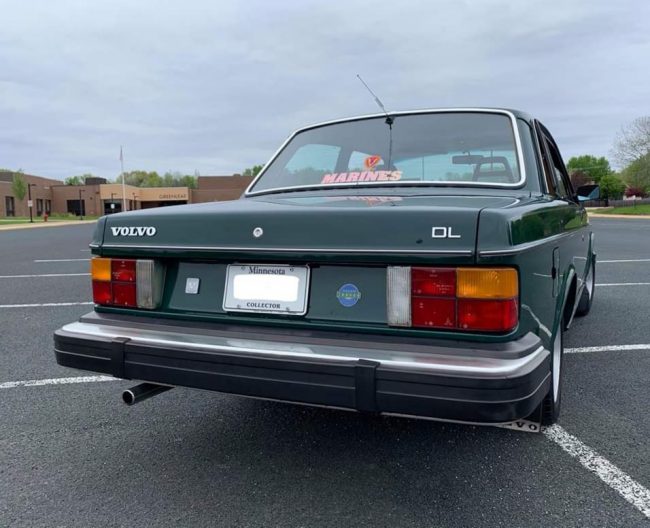
I remember both the 245 and the Bonnie very well, along with the red 1973 Volvo 1800ES my mom also had, and the rusty, crusty, but completely fascinating ’51 Porsche (fondly referred to by my mother as ‘that green piece of crap’). But not too long after I was into my toddler years, the Pontiac went away, and a new Volvo DL two door, in nonmetallic maroon with a tan cloth interior, took its place.
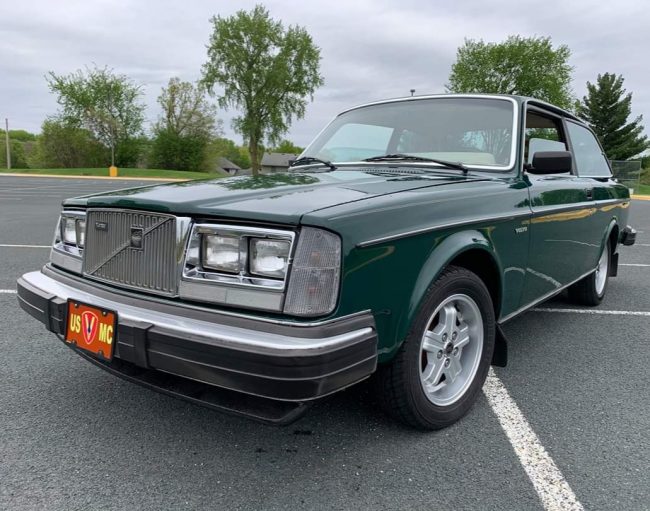
Anyway, today’s retro-’80s specimen was posted this past Tuesday evening by my friend Dustin Carpenter. He has no ties to the seller, but the car was relatively local to him. Of course I was immediately reminded of the maroon ’81 Volvo DL two door my dad had. It actually replaced the metallic root beer brown Bonneville previously mentioned.
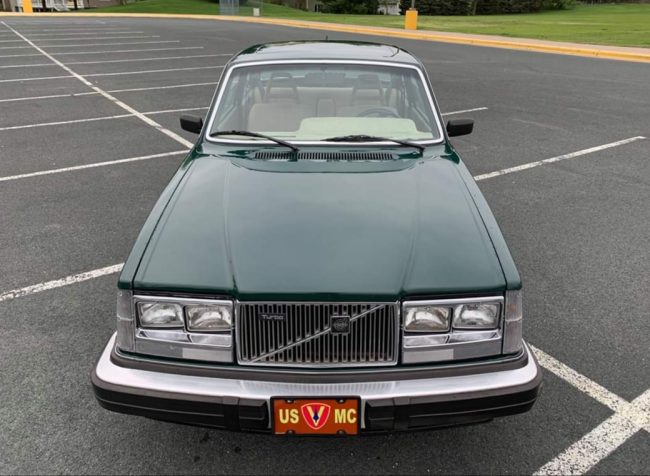
I do remember riding in it, but remember Mom’s wagon much better. About two years after the two door 240 came home, my first sibling, my brother Andy arrived, and the DL was traded in on a four door, fancier silver 240 GL sedan, with tan leather, turbine alloy wheels and a sunroof.
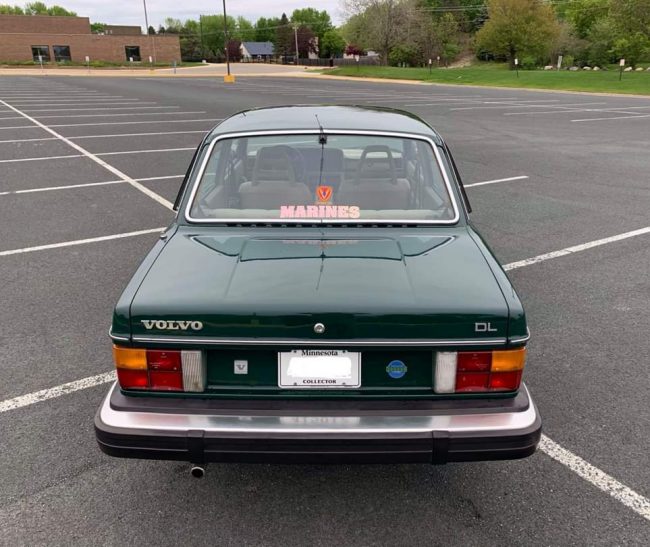
Shortly before it went away, I remember my grandma Ruby was interested in acquiring the maroon two-door. But either she changed her mind or Lundahl Volvo in Moline sold it before she had a chance to buy it. Perhaps it was just as well, she had a mint condition 1977 Thunderbird, black with white bucket seat interior and factory AM/FM/CB stereo.
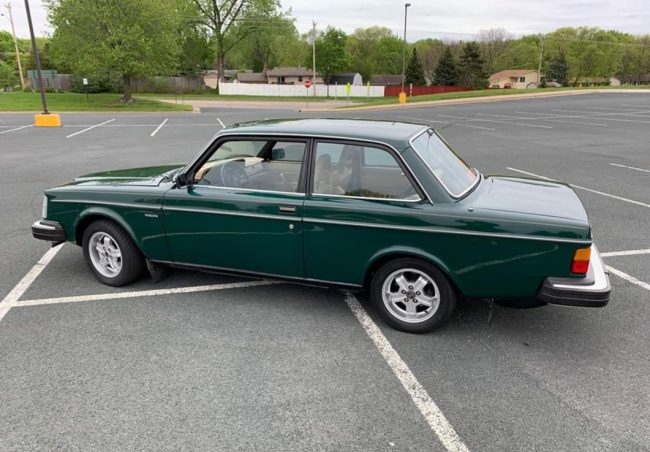
Anyway, on to the featured car’s history. As the seller stated, “I bought this car from the original owner that lived in CA who parked it in his garage with a car cover on. It shows, this thing is clean.”

“The car was repainted entirely in the early 90s when there was a fender bender (drivers side rear quarter) and instead of partial paint, he paid to have the entire car repainted. However, there are some very few minor imperfections and a few areas of overspray and is not pristine around some of the window edges, but I am pretty damn picky.”
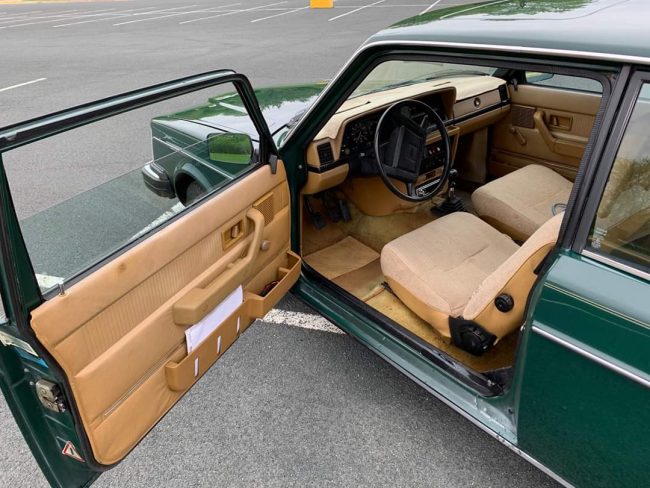
“Interior is in great condition minus the tear on the side of the drivers seat, and typical dash crack. But the thing is still 38 years old with almost 250 on the clock.”
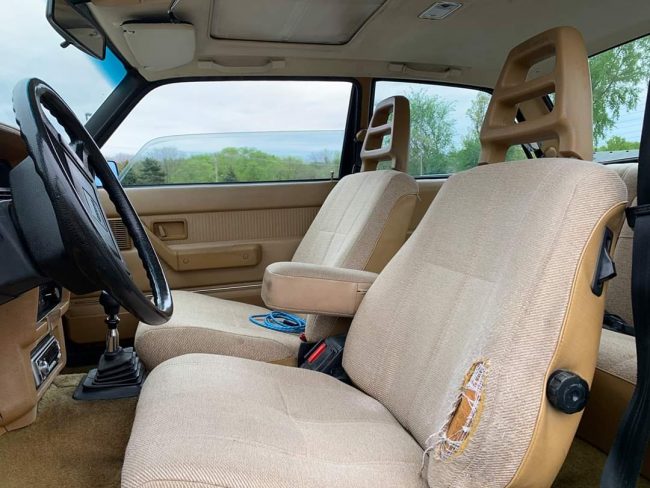
“I am in the process of looking for a new carpet insert and drivers seat, and recovering the rear window insert behind the rear seat, which is currently removed.”

“I have the original grill without the turbo badge, it just isn’t as clean as this grill. (FYI turbo badge or not, this thing is still slow, just a little slower than the ones with the actual turbo). I also have some extra turn signals and some other miscellaneous parts (Motor and transmission mounts, New in box).”

“Oh yeah, the sunroof and power antenna also work, I do believe, that the power antenna was not an option until 85, but when they repaired the rear quarter the update was made and the wiring was updated to add the power antenna as well.”
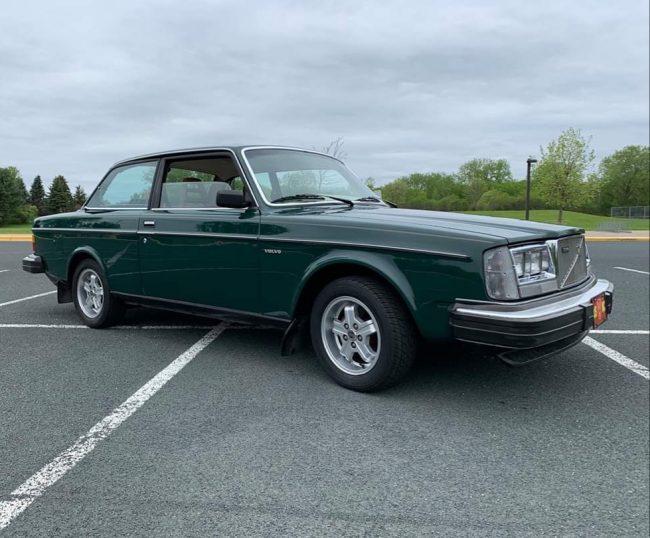
“MN Collector Plates, no need to renew registration, if it stays in the state. (No shit, itdoesn’t transfer out of state) who would have thought.”
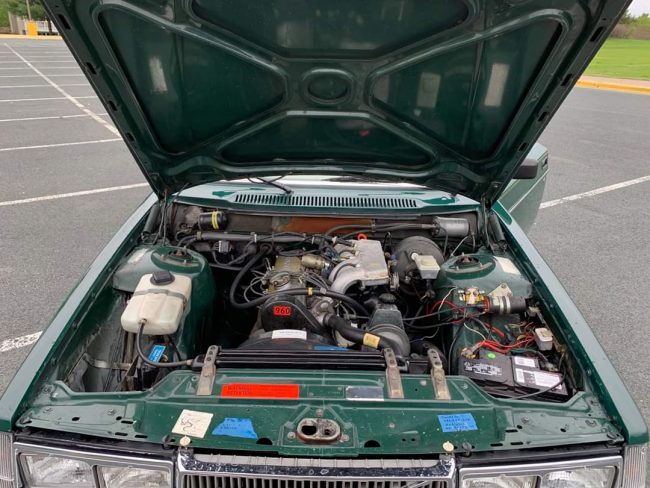
Clean Title. $9,500. Is totally the crack pipe price…(jalopnik anyone)…apparently some of you have no sense of humor. I’ve seen some 242s no where near as clean as this recently go for an easy 5k, a car is only worth what someone is willing to pay.”
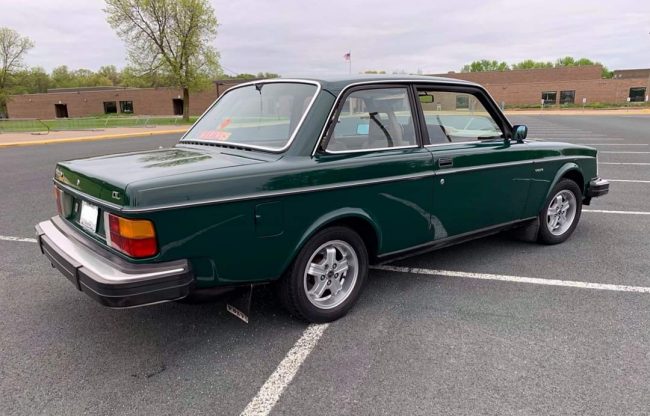
“If you’re interested shoot me an offer with your phone number attached. I enjoy a good negotiation, but know that 5K is not going to do it for this one, and I may find out that I won’t find a buyer at that price, oh well, then I‘ll just have to keep on enjoying this green machine.”
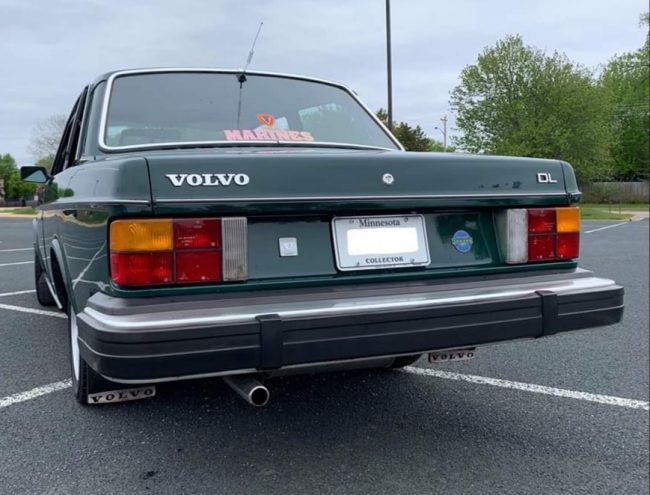
Anyway, there you have it. A nice example, but do remember these were reliable, but not terribly exciting. But I had to share this, because it ignited some long-dormant memories when I saw the photos this Tuesday evening! And as always, keep calm and always tip your bartender folks!







20 Comments
Solid economical car with good seats and I very much like the color combination.
Toms telling us of the story of the example in his family and the cars it replaced, or nearly replaced, takes us back to the early eighties and what was being asked of us as Americans. Austerity and the choice of cranky carbs or maintaining something with Lamda Sond. Think of the comparison of the if anything more expensive 242 compared to the luxury and nvh of the V8 Bonneville or Thunderbid. Remember though that by 82 the Bonneville was a midsize and the Thunderbird was a fancy Fairmont. Both had rough and slow 90 degree V6s with cranky carbs. Austerity everywhere you look all thanks to the middle east and the foolishness of involving ourselves with them.
If tiny little Volvo could figure out how to equip their cars with fuel injection, 3-way catalysts, OHC, over-drive manual transmissions, and very comfortable seats while paying expensive Swedish labor and the added expense of shipping across an ocean and selling via a small dealer network in the big USA, what was the excuse for Detroit’s continuation with troublesome “computer controlled” carbs? Why did it take Detroit 10 years after the first oil crisis to introduce an overdrive automatic – they invented the damn things so it wasn’t lack of know-how? Why did mighty GM invest billions in clean-sheet designs for the X and J bodies and equip them with yester-tech 4 speed manuals/3 speed automatics mated to OHV carbed motors? It certainly wasn’t because they were sweating the details on quality control. When you fall behind little Volvo in technology, there is more than austerity to blame.
Do you really think this unbalance shafted shift for yourself 2.3 liter four matched the ease of use, smoothness of the V8s it was replacing? You know very well it wasn’t. This was austerity, albeit expensive austerity. All the manufacturers were throwing extra gears and injection at engines to try to minimize the effect of what was being lost. They thought they had to and maybe they were right. The losses were real.
I am no fan of Volvos from that era, but I think they did very well given their very small engineering staff and budgets compared to what Ford and GM and even Chrysler had at that time. When GM was developing new engines in the late 70s and 80s, why didn’t they move to OHC and fuel injection? When they were developing new transverse gearboxes during the same time, why didn’t they try to jump ahead of Japan and Germany by making 5 speed manuals and 4 speed OD automatics? They had more resources than all the other automakers combined and they went for mediocre in the face of demands for better fuel economy and growing European and Japanese competition. Sure GM made nice quiet cars with smooth, but smog choked V-8s mated to a smooth 3 speed automatic without OD or lock-up torque converters. Detroit and especially GM could have and should have done a lot better.
Maybe they did not think that OHC would enhance the ample low end torque that American buyers were used to. They also had to build cars that could stand up to American maintanance habits, which didn’t involve frequent, expensive belt changes. Every 30k recomended on 240s if I am remembering correctly. Remember GM also was out with a simple cheap FI system for the 2.5 and the 1.8 X and J car fours early while Mazda and Honda had to wait many more years. It offered all the avoiding stalling, surging and dieseling of the VW Bosch system without the expense and complication. Engineering prowess much copied.
I know you think your perspective as a well off import buyer is that sophistication is an end to itself. People like you and me are not going to keep a car for a decade/150k. The big three had to think of the wider market however deplorable.
In fairness this Volvo wasn’t competing at the same price point as a Citation. It would have sold new for Oldsmobile, Mercury or Chrysler New Yorker money, and in most of the aspects that buyers actually cared about you were getting a lot more car for your money buying domestic.
You are correct that the 240 and Citation were not direct competitors, but my point is that GM had huge economies of scale and engineering abilities that Volvo couldn’t even dream about, and they didn’t take advantage of it. By the time the Citation was introduced, lots of cheap Japanese cars had 5 speed gearboxes, so why didn’t GM try to match them? VW was putting fuel injection on their relatively cheap Golf/Rabbit from 1977, so why couldn’t GM put it on their X-Bodies (or at least make it an option)?
Citation had standard fuel injection in 1982. Don’t let the facts get in the way way of shiiting on your own country. Also the 4th gear overdrive in the stick and the direct drive 3rd on the autos were taller and more relaxed than any 82 Toyota, Honda, Mazda, Nissan or VW competition. Easily done because they did not need drag strip gearing to band aid no torque.
List of Citation competitors in 1982 with FI: Renault 18i, Jetta, Fiat Brava. Hmm, would any of these stand up long term to family use?
Without, Accord, Corona, 626, Stanza, Fairmont, Aires, Concord,
I’ve been reading some malaise era car magazines. In the early years the Rabbit was very well received once fuel injection was standard, although they had serious quality and durability issues just like small cars from GM and Ford. They also became very expensive once fuel injection was included, something that shifting production to Pennsylvania failed to address. There was no cheap fuel injection solution until microprocessor costs tumbled, allowing fuel injection to improve in affordability and effectiveness simultaneously. Fuel injected Rabbits were winning subjective evaluations in comparison tests while competitors were recommended as alternatives for people who didn’t want to pay intermediate-money for their econobox.
I don’t think GM’s scale would have allowed them to sell good fuel injection cheaply until the technology to mass produce the chips was developed. There was no economy of scale involved in soldering boards by hand. VW-Audi sold plenty of fuel injected cars world-wide, but the costs remained high and the fuel injection was less than ideal.
Lets give the low end torque myth a rest. CAFE meant that most of the 1982 Volvo’s domestic competitors were hobbled by far smaller engines than they enjoyed a decade earlier paired with obscenely tall final drive ratios resulting in lethargic response at every speed. The four-speed automatics arriving at the time were a help, but they were a help that came with fragility and transmissions that uncomfortably hunted between 3rd and 4th gear constantly at almost any steady speed. Saying these cars had low end torque is just a marketers way of saying they couldn’t breath and didn’t make any power.
Volvo was the “Prius” of its era: college professors, managers, and virtue signalling upper middle class moms drove them. Normal folks had Beetles and Fords, cos the maintenance costs were insane, especially as they aged (my buddy made a fortune at his Volvo shop; nowadays, he’s a Honda/Import repair shop, due to the lack of Volvos still around).
I think these were more like Subarus or pickup trucks- “lifestyle cars”. Once people started driving them, then just kept getting newer versions when the old ones wore out. The only people who I knew with Volvos were military officers and Protestant ministers (various denominations). They almost always had two – about four years apart. I grew up in the Northeast (close to Ft. Devens (Army), South Weymouth (Navy), and Pease AF Base); so maybe that had something to do with it?
In my experience, it was Saabs that were virtue signal machines.
Jeff,
You are hit it on the nail head. This generation of Volvos was the car of choice for “college professors”, “government bureaucrats”, and the liberal elite of Georgetown. In other words, people who hated cars and looked down on anything “American” loved these cars because they were sending a signal to their peer liberal elites.
My problem with this generation of Volvos is that they could not get out of their own way, and what was it. These cars they were built in the cold confines of Northern Europe and yet they rusted almost at a rate that would give a 1970’s Vega race, and a Vega would rust on the showroom floor. Not a competition that a upscale Euro manufacture would have wanted to win I would think but Volvo seemed to be all in on obsolence by rust.
Tom always enjoy reading your personel connections to the subject of your review, adds context to the article.
My big brother bought one of these used, about 5 years old, at an auction .
It was parked in the middle of a mud puddle so we should have avoided it .
It was slow and very drab but he seemed to like it until the title turned up to have problems and then the fuel injection sub harness bio – degraded, we never did get the york AC compressor to work and in the end he junked it although the bank that illegally sold it and didn’t disclose the title and collision damages it had, wound up transferring the title and out of date tags into his name then paid him $42,000.00 to go away .
It was when new, an O.K. car I guess but those old bricks were so damned stodgy I could never want one .
-Nate
I had a 940 naturally aspirated wagon with that iron-wearing cloth. Probably the latest-manufactured (not designed, as the 740/940 were 240s with the stupid designed out) car designed for home serviceability, with the notorious heater core exception. Belts could be changed on the roadside with minimal tools as it’s right up front.
Silly question :
Isn’t heater core failure caused by failure to maintain the cooling system ?.
I once had a 1970 Volvo 144S, it was stodgy and slow, had the same weird heater the very last thing out of the dashboard, it never leaked but the damned fan motor gave up the ghost, what a pisser of a job to replace, I sold the damned thing instead .
That car and the 240 both stupidly had the ash tray just _ABOVE_ the radio/cassette guaranteeing it’s rapid choking with ashes and death…
-Nate
I had a 1985 VW Jetta GL. The heater core blew at about 70,000 miles. I took it to my local VW-Audi independent specialist who commented that they all did that, and he showed me why. He had a home-made pressure testing jig on the wall of his shop. He removed the radiator cap from my car and fitted on the jig. Then he increased the pressure to about 10% over the level at which the cap was supposed to open the passage to the spillover tank. Nothing happened. The failure mode of the radiator caps VW was using involved not retracting the center piston that was supposed to release pressure in the cooling system. That’s what blew 99% of Golf/GTI/Jetta and Scirocco heater cores. Would you consider that maintenance related?
I also watched as the shop owner tore open a bag of new VW radiator caps from Germany, which he then started testing on his jig and rejecting a meaningful percentage of right out of the package. They were defective, and this was in about 1990, long after the problem had been identified.
Holy crap, that’s terrible .
Not surprising considering what I’ve been hearing about VWAG for the last twenty years .
I was out junkyarding Monday and ran across two of these 240DL bricks, both looked pretty good, the one in that light blue (? Lavender ?) color had shiny paint even …..
Yes, I own and like German vehicles, no, I do not ever recommend anyone to buy one .
-Nate
I’m surprised decent bricks are still getting scrapped. When the second generation Prius hit over fifteen years ago, junkyards filled up with most of the good ones; driven there by over-privileged ecowarriors who didn’t want anyone else using them to pollute the environment now that they had found enlightenment at the end of the 2004 Oscars’ red carpet. I figured the people who had them now really liked them, and would only part with them with crash damage or having fully consumed their utility.
The blush flew off the Volvo rose some time ago, even here in La La Land .
Prius hate remains strong because of the imbecilic first generation buyers who were an insufferable lot .
-Nate
First generation Priuses were also like the suitcase-sized VCRs that early-adopters heated their homes with. They weren’t quite ready for primetime. Second generation Priuses were fully baked though, and it is a shame they were embraced by the bumper sticker crowd. My ideal daily driver has a stick and steering feel, but the Prius MK2 was just the thing for an hour-long gridlock commute.